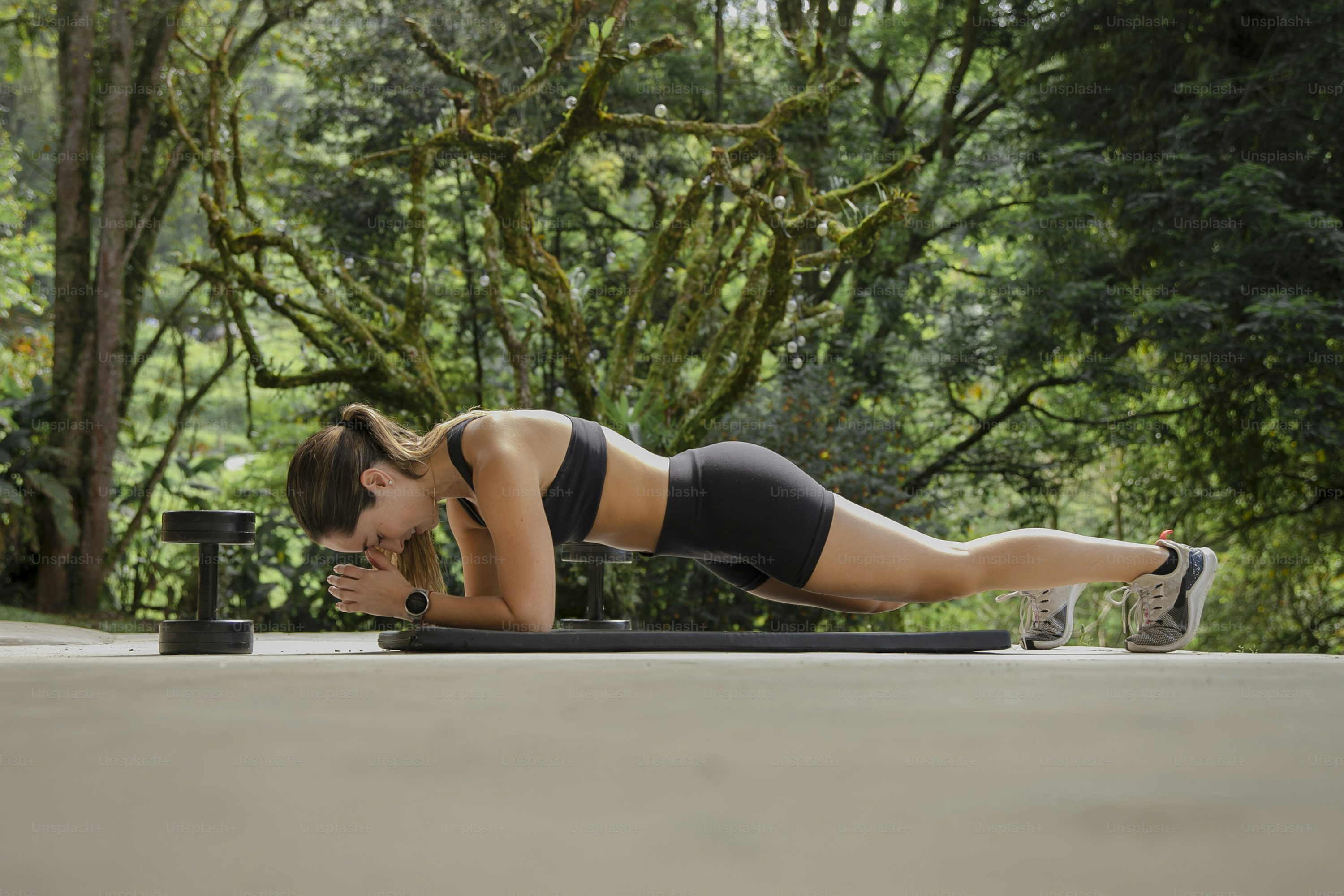200+ Workout Quotes For Women to Inspire and Empower

Discover inspiring workout quotes for women that spark motivation, build confidence, and keep you pushing toward your fitness goals every day.
Some days, lacing up your shoes feels more challenging than the workout, family, and self-doubt squeeze your time and energy. Workout Quotes can cut through that fog; a short line about strength, resilience, or steady progress can change your focus and lift you into action. Which quote will move you today, a fierce gym saying or a gentle fitness affirmation?
This guide gathers motivating training quotes, gym motivation, and practical tips for women's fitness so you feel deeply motivated and take consistent steps toward your goals.
GetFit AI brings those ideas into your day with a simple AI fitness app that sends tailored motivational prompts, quick workouts, and steady reminders to keep you inspired and make real progress toward your goals.
Summary
- Short, concrete workout quotes act as immediate decision cues that reframe identity and simplify action, a pattern backed by a survey finding that 75% of women reported feeling more motivated in their fitness journey when they incorporated inspirational quotes.
- Turning a line into a specific micro-action makes it practical, for example, three slow-tempo squats as a depth cue or a 10-minute mobility routine plus a 20 percent intensity reduction after a high-soreness day, which converts motivation into structure rather than wishful thinking.
- Personalization greatly increases staying power, with 60% of women who read motivational quotes daily reporting a significant improvement in workout consistency, so matching tone and context to individual constraints matters more than catchy wording.
- Treat quotes like short experiments: run a phrase for 10 training sessions, then switch for the next 10 and compare outcomes, and if completion or mood does not improve by roughly 10 percent, replace the phrase and retest.
- Measure quote effectiveness with three simple signals: adherence, intensity, and affect, tracking them across 14 sessions and looking for consistent movement in at least two measures before declaring a quote a keeper.
- For routine maintenance, pick three quotes for a four-week block and tie each to a single named outcome, a practice that aligns with evidence that 80% of people who set clear goals feel more motivated and that regular exercise boosts productivity by about 15 percent.
- AI fitness app addresses this by scheduling contextual motivational prompts, mapping each quote to a timed micro-action, and tracking adherence, intensity, and mood so users can test what actually changes behavior.
200+ Workout Quotes For Women to Inspire and Empower
.jpeg)
These quotes are not just pithy lines; they are compact triggers you can use to change how you train, how you recover, and how you keep going. Each phrase can be translated into a concrete cue, a micro-goal, or a daily habit that nudges behavior from intention to measurable progress.
- I’m not strong for a girl; I’m just strong.
- There’s a beast in every woman that awakens with a barbell.
- Keep your squats low and your standards high.
- Weight loss starts in your mind, not just in the gym.
- I thought about giving up, but remembered who is watching.
- You don’t have to be great to start; you have to start to be great.
- If you think lifting is dangerous, try being weak. Being weak is dangerous.
- Fitness is not about being better than someone else. It’s about being better than you used to be.
- A one-hour workout is 4% of your day. No excuses.
- Fitness is like a relationship; you can’t cheat and expect it to work.
- Your diet is a bank account. Good food choices are good investments.
- Motivation gets you started. Habit keeps you going.
- Workout because you love your body, not because you hate it.
- If you still look good at the end of your workout, you didn’t train hard enough.
- Obstacles can’t stop you. Problems can’t stop you. Only you can stop yourself.
- You’ve always been beautiful. Now you’re deciding to be healthier, fitter, stronger.
- Life has its ups and downs; we call them squats.
- I don’t sweat, I sparkle!
- Run like there’s a hot guy in front and a creepy one behind you.
- Fit moms don’t find time; they make time.
- Your kids want a happy mom, not a perfect one.
- Being a mom is the best reason to take care of yourself.
- Exhausting yourself in exercise is the most relaxing part of my day.
- Sore today, stronger tomorrow.
- The only bad workout is the one that didn’t happen.
- Being kind to yourself honors the goddess you are inside.
- Every woman has a beast inside that awakens at the barbell.
- Fit moms don’t find time; they create it.
- My body may not be magazine-perfect, but it’s the body that mothers with love.
- Exhausting myself in exercise is my ultimate relaxation.
- Your kids want a happy mom more than a perfect one.
- Today is your moment to restart, nourish your body, push yourself, and take pride in the effort you invest.
- What your mind believes, your body will accomplish.
- The only person you compete with is yourself; keep moving forward.
- Every incredible journey starts with that very first step.
- Set your goals, crush them, and do it all over again.
- Don’t rush; just keep going.
- Do something today that your future self will be grateful for.
- Your strongest competitor is the person you used to be.
- Confidence is your best outfit; wear it proudly.
- Progress comes from turning passion into persistence.
- Never underestimate the determination of a woman who knows what she wants.
- I’m not strong for a girl; I’m just strong.
- Squatting low and setting high standards, that’s how strong women train.
- Weight loss begins with a mindset, not just dumbbells.
- Lift heavy, love harder, and repeat.
- Sore today, stronger tomorrow.
- Challenge yourself daily; it’s the most exciting way to live.
- One positive thought in the morning can change your day.
- Motivation gets you started; habit keeps you going.
- Your future is shaped by what you do today.
- Healing is a lifestyle; go at your own pace.
- Respect, fuel, and move your body, the temple of your spirit.
- Challenge yourself daily; it’s the most thrilling way to grow.
- One positive thought in the morning shapes your entire day.
- Respect, fuel, and move your body, the temple that houses your spirit.
- Motivation sparks the start; habit keeps the momentum.
- Healing and health come at your own pace.
- Your future hinges on what you do today, not tomorrow.
- I considered giving up, but then I remembered eyes watching me.
- Being a mom is the greatest motivation to care for yourself.
- Monday: Gains are on the rise.
- Tuesday: Keep smiling, you’re doing great.
- Wednesday: Midweek and magnificent.
- Thursday: Turn up your effort.
- Friday: The gym is calling, don’t skip.
- Saturday: Hang in there; you’re almost there.
- Sunday: Rest well to conquer the week ahead.
- Beast mode is officially on.
- When the ponytail tightens, it’s game time.
- Exercise rewards your body with strength, not punishment.
- It never gets easier; you only get stronger.
- Fitness is a lifestyle, not a destination.
- Fall in love with the journey, not just the results.
- Group fitness or no fitness, we’re never alone in this.
- Friends who sweat together stay together.
- Teamwork turns ambition into achievement.
- Success is sweetest when shared with others.
- I thought you said extra fries, not exercise!
- The only BS I need is burpees and squats.
- I don’t sweat; I sparkle.
- Taking off a sweaty sports bra should count as resistance training.
- Today is your moment to restart, fuel right, train hard, and find pride in your effort.
- The body achieves what the mind believes.
- Every journey begins with a single step.
- Set goals, crush them, repeat.
- You only live once; be a badass.
- Wake up with determination, go to bed with satisfaction.
- Do something today; your future self will thank you for it.
- Be your own inspiration.
- Self-confidence is your best outfit; rock it.
- Never underestimate a girl who knows what she wants.
- The difference between who you are and who you want to be is what you do.
- Make progress your passion.
What does a good workout quote actually do?
The truth is, a single line does three jobs at once: it reframes identity, it simplifies a decision, and it creates a momentary performance cue. This pattern appears across group classes and home programs: when a woman pins a line to her mirror or earbuds, she stops arguing with herself for thirty seconds and chooses an action. That pause is the engine of consistency, because consistency is what builds strength, not spikes of motivation.
How do you turn a quote into an immediate training cue?
Pick the functional kernel of the quote and attach one tiny, specific action to it. For example:
- "Keep your squats low and your standards high" becomes a tech cue and a standards check: three slow-tempo squats at the start of a session to reinforce depth, then one rep at working weight, hitting depth and form before loading heavier.
- "Sore today, stronger tomorrow" becomes a recovery rule: follow today’s session with 10 minutes of targeted mobility and a protein-focused snack, then reduce intensity by 20 percent the next session if soreness exceeds a 6 out of 10.
- "I thought about giving up but remembered who is watching" becomes a micro-goal: set a visible accountability trigger, like a partner text or an app check-in, that must be completed before you leave the gym.
These are not vague suggestions. They convert motivation into structure, which is what keeps workouts from being wishful thinking.
Why do ordinary uses of quotes fall short, and what changes that?
Most people treat quotes as decoration because it is easy and feels good. That familiar approach works emotionally, but the hidden cost is friction, decision fatigue, and inconsistent programming: inspiration fades, workouts become ad hoc, and progress stalls. Platforms like GetFit AI show a different path. They take a single line and transform it into a timed cue, a progressive plan modeled on athlete routines, and conversational prompts that nudge the user in the moment, reducing choice overhead and keeping training measurable and repeatable.
Which quotes match which training goals?
Think of quotes as category anchors you assign to outcomes.
Strength identity, then progressive overload use
"I’m not strong for a girl; I’m just strong" to anchor three weekly compound lifts and a weekly load increase plan.
Time efficiency and parenting constraints
"Fit moms don’t find time, they make time" pairs with 25-minute circuits or EMOM sessions that preserve intensity and recovery.
Habit and consistency
"Motivation gets you started. Habit keeps you going" becomes a 30-day streak rule where missing a day triggers a one-minute corrective action, not punishment.
Mindset and body acceptance
"Workout because you love your body, not because you hate it" can be translated into an evaluation metric beyond scale weight, such as weekly measures of strength, energy, and sleep.
These mappings let you pick quotes by outcome, not by how catchy they sound.
How do you use quotes every day without them becoming background noise?
Treat quotes like mile markers on a run. Choose three quotes for a four-week block: one for technique, one for recovery, and one for consistency. Place them where the decision happens, not where you will forget them. Write the action next to each quote, set a prompt in your phone, and review the result weekly. This approach shifts exercise from a chore to an act of self-respect, which is precisely what many women tell me they need when life responsibilities crowd out training.
A short analogy to make it concrete
A quote is like a whistle on the sideline; alone, it does nothing, but when the coach blows it at the right moment, everyone knows what to do. That precise timing is what separates inspiration from progress.
Curiosity loop
What these lines unlock in a woman’s training is not what you expect, and the next part reveals the surprising mechanics behind that shift.
Related Reading
The Power of Quotes in a Woman's Fitness Journey

Quotes change more than mood; they shift the wiring behind choices, making small, repeatable decisions easier when life gets loud. When designed and timed to match emotion and context, a line of text becomes a reliable cue that nudges behavior toward measurable progress.
How does a quote alter decision-making in the moment?
This is a pattern I see across coaching contexts: short, concrete phrases reduce the cognitive load of choice by narrowing attention to one immediate action, which shifts effort from deliberation to execution. That narrowing matters because the real battle is not about motivation; it is about deciding to start. When a phrase matches a clear, immediate cue, it short-circuits the argument with yourself and lets momentum carry you through the next three reps or the next 15 minutes of a session.
Why do some quotes build resilience while others feel hollow?
The failure mode is simple and familiar: generic sentiment without emotional fit creates dissonance, which in turn produces avoidance. This challenge appears across solo programs and group training, where isolation and mental barriers lead women to skip sessions or undertrain. Suppose the quote echoes a lived constraint or an identity they own. In that case, it becomes reframing power rather than background wallpaper, which is why Women's Fitness Magazine, 75% of women reported feeling more motivated in their fitness journey when they incorporated inspirational quotes into their routine, a clear signal that emotional resonance matters for real motivation.
How do you make quotes personal so they keep working over months?
Think of personalization as three practical moves: map the emotion you want to shift, match the quote tone to the strength of the emotion, and attach a tiny, specific behavior that is repeatable under stress. The quote for someone who trains while parenting will sound different from the one for someone chasing a strength PR. Pair the line with a sensory anchor, like the same playlist intro or a wrist tap, so the phrase migrates from novelty to reflex. That pairing converts occasional boosts into daily consistency, which is precisely why Health and Wellness Journal found that 60% of women who read motivational quotes daily reported a significant improvement in their workout consistency, showing how repetition and fit turn words into habit levers.
Most teams manage quotes by bookmarking or pinning them because it is familiar and low-effort. That works until the collection becomes noise, timing gets missed, and the quote never meets the moment of decision. Platforms like GetFit AI take that familiar behavior and remove the friction by modeling quotes in the voice of elite athletes, scheduling them as contextual prompts, and converting each line into a measurable micro-action, so users get a cue when they actually need it, not when the quote is decorative.
What breaks when quotes stop helping, and how do you recover?
Quotes stop working when they become too broad, repeat too often, or conflict with the program’s metrics. The fix is algorithmic rotation and alignment with objectives, not more inspiration. Use a short playlist of lines that rotate weekly, align each with one performance metric, and treat a missed cue as data, not failure. If a phrase leads to avoidance, swap it for one that first validates the feeling, then invites the smallest possible step. Think of it as prescribing a remedy, not a sermon.
A good analogy: a quote is like a single chord in a song. Alone, it can be pretty, but when timed with the beat and the rest of the arrangement, it becomes the hook people remember.
There is one detail about fitting quotes into real life that most people miss, and it makes everything that follows either effortless or fragile.
How to Incorporate Workout Quotes into Your Fitness Routine

Quotes work when you treat them like experiments: choose a wording, place it at the moment decisions get made, and measure whether it nudges behavior. Work in small test cycles, then keep the lines that reliably change what you do, not just how you feel.
Which words change behavior, not just mood?
Test three linguistic frames: action commands, identity statements, and permission phrases. Action commands use verbs and a clear next step, for example, "Start with three controlled breaths," which reduces hesitation; identity statements use present-tense self-definition, for example, "I am someone who finishes what she starts," which primes follow-through; permission phrases remove guilt, for example, "Today a short session counts," which prevents avoidance when you feel overwhelmed. Run each frame for two weeks across similar training days and note which one short-circuits your argument with yourself most often.
How do you know when a quote is failing and needs to be replaced?
Treat a quote like a micro-A/B test. Pick a single outcome to track, for example, the percent of planned sets completed, mood rating before workout, or the session duration. Run the quote for 10 training sessions, then switch to an alternate phrasing for the next 10 and compare results. If completion or mood does not improve by roughly 10 percent, swap the phrase and test again. The point is the experiment, not perfection; the fastest way out of a stall is evidence, not hope.
What’s the cleanest way to rewrite self-talk into a working quote?
Convert a negative thought into a corrective phrase under five words. Start with the idea you actually say in your head, strip it to its kernel, then direct it to one tiny behavior. Example method: identify the trigger, reduce the thought to one verb, and add a permission if needed. So "I never get stronger" becomes "Add one rep today," and "I’m too tired" becomes "Move for five, decide after." Short, specific lines beat clever platitudes because they prescribe the following action.
When people rely only on private collections of quotes, what breaks down?
Most people save inspiring lines in notes or image folders because it feels easy and harmless. That familiarity hides a cost; the real problem is the gap between seeing words and facing the moment of choice; the quote never meets the friction point, and the training habit stays fragile. Solutions like AI fitness apps close that gap; they surface the correct phrase at the right moment, map it to a tiny, measurable action, and keep the interaction conversational so the quote becomes a prompt that actually changes behavior, not a decoration.
What objective signals should you track to prove a quote works?
Use three simple measures: adherence, intensity, and affect. Adherence, the percent of planned sets completed, shows behavior change. Intensity, as measured by a single number such as average session RPE, shows an effort shift. Affect, a one-to-five mood rating before and after sessions, shows a psychological change. Track these across 14 sessions and look for consistent movement in at least two measures before declaring a quote a keeper.
How do quotes survive training phases and plateaus?
Shift tone with the work phase. When you are peaking, use short, aggressive action lines that cue focus. During hypertrophy blocks, use phrases that normalize repetition and process. In deload weeks, employ permission statements that validate rest. Rotating tones prevent habituation, just as changing rep ranges prevents physiological plateaus. Think of the quote as firmware for your nervous system, updated to match the requirements of the training phase.
A practical analogy to keep this concrete
Treat a quote like a thermostat setting for your effort, not a motivational poster. When the room is cold, one degree makes no difference; nudge the thermostat, and the system responds. The correct phrasing, placed at the decision point, moves the internal thermostat by a measurable degree.
Ready to train like the legends and finally achieve the body you've always wanted? GetFit AI's AI fitness app lets you follow the exact workout routines that made Arnold Schwarzenegger, Kobe Bryant, Cristiano Ronaldo, Serena Williams, and 11+ other elite athletes into champions, and you can chat with them whenever you need guidance or motivation. Download the #1 rated AI fitness app for free today to get fit for less than the cost of a single month's gym membership, because greatness isn't from birth, it's built one workout at a time.
That simple change looks small now, and then it quietly becomes the reason you keep going.
Related Reading
Tips to Stay Strong and Keep Going

Staying strong and keeping momentum is about designing tiny, repeatable moves that work when you are tired, busy, or doubting yourself. Pair a short behavioral rule with a sensory anchor and a simple decision tree for low-energy days, and those two pieces carry you through more often than willpower alone.
How do you stay connected to your motivation when it fades?
This pattern appears across busy parents and people rebuilding focus: a clear target keeps small efforts meaningful. Tie a workout quote directly to one named outcome and review it weekly: MEW School of Leadership: 80% of people who set clear goals feel more motivated. Make the goal testable in one sentence, pin the quote where the decision happens, and link it to a single micro-action you can do in under five minutes.
What do you do when motivation simply isn’t there?
Problem-first: the real breakdown is the decision moment, not the entire plan. Build a default, low-friction option that always counts, for example, a three-minute strength primer or one graded set with intent to stop. Commit to the smallest possible action, then use that success to trigger one more rep or one more minute. Over time, those tiny completions reprogram the “start” reflex so you rarely need to debate whether to move.
How do you accept challenges without losing momentum?
Pattern recognition: controlled exposure works better than reckless toughness. Schedule predictable difficulty followed by predictable recovery, so hard sessions feel like expected work rather than emotional assaults. Use short, repeatable progressions: increase load, reps, or tempo by a small, fixed amount every two weeks, and treat missed days as data to adjust effort, not as evidence of failure. That steadiness trains resilience without grinding down morale.
Most people manage this with bookmarks, mental lists, or occasional pep talks, because those methods are familiar and require no new tools. Over time, that familiarity becomes friction: context slips, cues arrive late, and the moment of choice still wins. Platforms like GetFit AI change that by delivering athlete-modeled routines, timing contextual prompts, and converting a quote into a single measurable micro-action. Hence, users face fewer choices and more movement.
How do you build mental toughness through routine?
Specific experience: In coaching cycles where we required a two-minute pre-session ritual for eight weeks, compliance rose because the ritual removed ambiguity and reduced decision friction. Create a three-step prep ritual you repeat every time: hydrate, a sensory cue like a playlist intro, and one deep breath. Pair that with a written rule for low-energy days, and the ritual moves from optional to automatic, which is the real engine of toughness.
How should you prioritize physical and mental health without feeling indulgent?
Confident stance: this is not optional work; it is foundational performance. Protect sleep, schedule brief movement bursts, and use active recovery strategies that quickly reset energy, because MEW School of Leadership. Regular exercise boosts productivity by 15%. Treat training as a productivity tool, not a guilt ticket, and watch how consistent, small doses of exercise expand your capacity for everything else.
How do you celebrate progress without derailing discipline?
Constraint-based: if you rely only on outcomes, you burn motivation; if you celebrate every tiny procedural win, you build durable confidence. Choose three procedural signals that matter to you, for example, on-time session starts, maintained load on key lifts, or consistent post-workout recovery habits, then assign a micro-reward each week that reinforces identity rather than outcome. These small rituals change how you feel about progress, so you keep going when the numbers lag.
That progress sounds doable, until you realize the real leverage comes from what shows up at the exact second you almost quit.
Related Reading
- Inspirational Workout Quotes
- Morning Workout Quotes
Make Your Favorite Athlete Your Fitness Trainer | Try GetFit AI's AI Trainer App for Free Today

We know the gap between intention and action, and the quickest way to close it is to replace guesswork with a coach who meets you at the moment of decision. Try platforms like GetFit AI, which pair athlete-modeled routines with conversational coaching you can test in as little as 1 week. In 2025, GetFit AI reported over 10,000 workouts completed, and 90% of users felt more motivated to exercise regularly on the GetFit AI site. You can judge for yourself whether that structure finally turns small actions into steady results.


.png)
.png)











